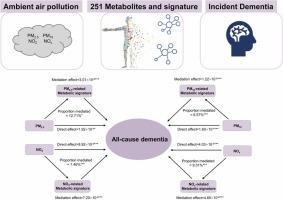通过代谢组学分析确定空气污染与痴呆症风险相关的特征和生物标志物:一项前瞻性队列研究
IF 12.2
1区 环境科学与生态学
Q1 ENGINEERING, ENVIRONMENTAL
引用次数: 0
摘要
接触空气污染与痴呆症的增加有关。然而,在这种关系中起作用的具体代谢机制是什么仍是未知数。我们从英国生物库队列研究中纳入了 192,300 名无痴呆症的参与者。根据居住地址对年度空气污染浓度进行了评估。通过弹性净回归确定与空气污染相关的代谢物,并构建代谢评分。通过 Cox 回归模型和协方平衡广义倾向得分(CBGPS)回归模型来探讨空气污染/代谢特征与痴呆症风险之间的纵向联系。研究还探讨了代谢特征或特定代谢物驱动的空气污染与痴呆症之间的潜在机制。共记录了 2,592 例痴呆症病例。我们确定了与空气污染暴露相关的代谢物特征,包括87个PM2.5代谢物、65个PM10代谢物、76个二氧化氮代谢物和71个氮氧化物代谢物。与空气污染相关的代谢特征与痴呆症风险增加有关,PM2.5、PM10、二氧化氮和氮氧化物的危险比(HR)分别为 1.17(95% CI:1.12,1.22)、1.06(95% CI:1.02,1.11)、1.16(95% CI:1.10,1.21)和 1.17(95% CI:1.12,1.22)。使用因果模型时,这些关联仍然存在。代谢特征介导了空气污染暴露与痴呆症风险之间的关联,介导比例为 6.57% 至 12.71%。此外,我们还观察到中型 VLDL(M-VLDL-FC)中的游离胆固醇代谢物起到了关键的中介作用。我们的研究为了解空气污染暴露与痴呆症风险之间的代谢机制提供了新的视角。本文章由计算机程序翻译,如有差异,请以英文原文为准。

Metabolomic profiling identifies signatures and biomarkers linking air pollution to dementia risk: a prospective cohort study
Exposure to air pollution has been associated with increased dementia. However, it remains unknown what specific metabolic mechanisms play a role in this relationship. We included 192,300 dementia-free participants from the UK Biobank cohort study. Annual concentrations of air pollution were assessed based on the residential address. Elastic net regression was performed to identify air pollution-related metabolites, and metabolic score was constructed. Cox regression models and covariate balancing generalized propensity scores (CBGPS) regression models were conducted to explore the longitudinal associations between air pollution/metabolic signatures and dementia risk. The underlying mechanisms between air pollution and dementia driven by metabolic signature or specific metabolites were also investigated. A total of 2,592 incident dementia cases were documented. We identified the metabolite profiles in response to air pollution exposure, including 87 metabolites for PM2.5, 65 metabolites for PM10, 76 metabolites for NO2, and 71 metabolites for NOx. The air pollution-related metabolic signatures were associated with increased risk of dementia, with hazard ratios (HR) of 1.17 (95% CI: 1.12, 1.22), 1.06 (95% CI: 1.02, 1.11), 1.16 (95% CI: 1.10, 1.21), and 1.17 (95% CI: 1.12, 1.22) for PM2.5, PM10, NO2 and NOx, respectively. The associations persisted using causal models. Metabolic signatures mediated the associations between air pollution exposure and dementia risk, with mediation proportions ranging from 6.57% to 12.71%. Additionally, we observed that a metabolite known as free cholesterol in medium VLDL (M-VLDL-FC) played a crucial mediating role. Our study provides novel insights into the metabolic mechanisms linking air pollution exposure to dementia risk.
求助全文
通过发布文献求助,成功后即可免费获取论文全文。
去求助
来源期刊

Journal of Hazardous Materials
工程技术-工程:环境
CiteScore
25.40
自引率
5.90%
发文量
3059
审稿时长
58 days
期刊介绍:
The Journal of Hazardous Materials serves as a global platform for promoting cutting-edge research in the field of Environmental Science and Engineering. Our publication features a wide range of articles, including full-length research papers, review articles, and perspectives, with the aim of enhancing our understanding of the dangers and risks associated with various materials concerning public health and the environment. It is important to note that the term "environmental contaminants" refers specifically to substances that pose hazardous effects through contamination, while excluding those that do not have such impacts on the environment or human health. Moreover, we emphasize the distinction between wastes and hazardous materials in order to provide further clarity on the scope of the journal. We have a keen interest in exploring specific compounds and microbial agents that have adverse effects on the environment.
 求助内容:
求助内容: 应助结果提醒方式:
应助结果提醒方式:


